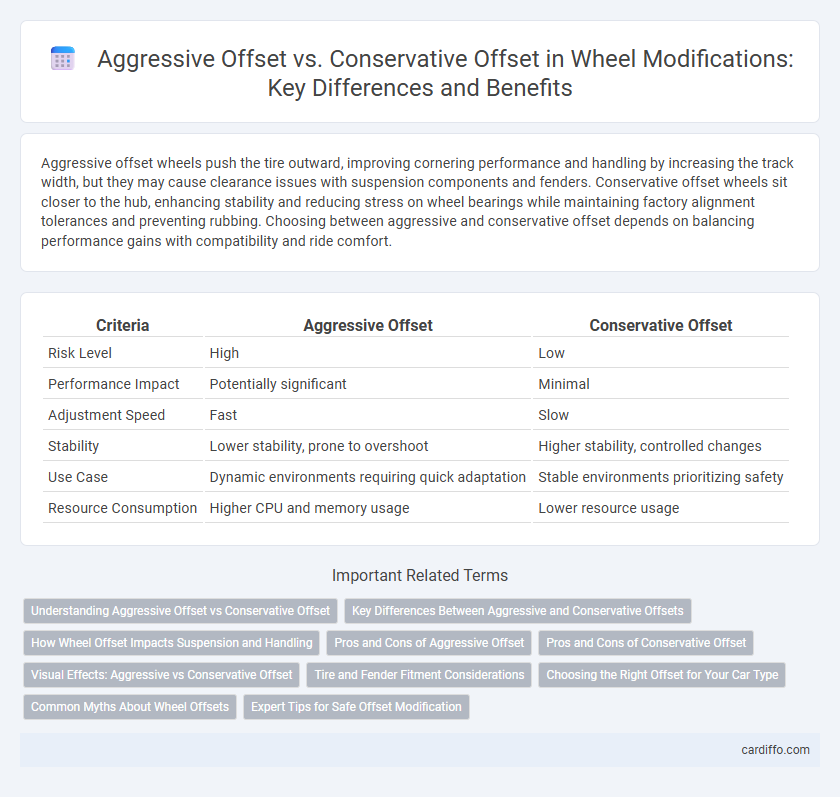Aggressive offset wheels push the tire outward, improving cornering performance and handling by increasing the track width, but they may cause clearance issues with suspension components and fenders. Conservative offset wheels sit closer to the hub, enhancing stability and reducing stress on wheel bearings while maintaining factory alignment tolerances and preventing rubbing. Choosing between aggressive and conservative offset depends on balancing performance gains with compatibility and ride comfort.
Table of Comparison
| Criteria | Aggressive Offset | Conservative Offset |
|---|---|---|
| Risk Level | High | Low |
| Performance Impact | Potentially significant | Minimal |
| Adjustment Speed | Fast | Slow |
| Stability | Lower stability, prone to overshoot | Higher stability, controlled changes |
| Use Case | Dynamic environments requiring quick adaptation | Stable environments prioritizing safety |
| Resource Consumption | Higher CPU and memory usage | Lower resource usage |
Understanding Aggressive Offset vs Conservative Offset
Aggressive offset involves setting the vehicle's wheels closer to the suspension, creating a wider track and a more aggressive stance that enhances cornering and handling performance. Conservative offset positions the wheels more inward, providing better clearance for suspension components, improved ride comfort, and reduced stress on wheel bearings. Understanding these offsets is crucial for achieving the desired balance between aesthetic appeal, performance, and mechanical reliability in vehicle modification.
Key Differences Between Aggressive and Conservative Offsets
Aggressive offsets prioritize maximum performance gains by significantly advancing or retarding ignition timing and increasing fuel delivery, often leading to higher engine output but increased risk of knocking and reduced engine longevity. Conservative offsets adopt modest adjustments to ignition and fuel settings, aiming for balanced improvements in power and efficiency while maintaining engine reliability and minimizing potential damage. The key differences lie in the trade-off between performance enhancement and engine safety, with aggressive offsets pushing the limits and conservative offsets favoring longevity and stability.
How Wheel Offset Impacts Suspension and Handling
Aggressive wheel offset positions the tire further outward, increasing track width and improving cornering stability but placing additional stress on suspension components and wheel bearings. Conservative offset keeps the wheel more inward, preserving suspension geometry and reducing wear while slightly limiting maximum handling potential. Proper offset selection balances handling performance with suspension durability for optimal vehicle dynamics.
Pros and Cons of Aggressive Offset
Aggressive offset wheels enhance vehicle handling and provide a more muscular stance but can increase the risk of suspension and tire wear due to altered stress distribution. They improve cornering performance by widening the track width yet may cause clearance issues with fenders and steering components. While offering improved aesthetics and driving dynamics, aggressive offset setups often require careful alignment adjustments to maintain optimal wheel balance and longevity.
Pros and Cons of Conservative Offset
Conservative offset in modification prioritizes stability and safety by minimizing drastic changes to vehicle dynamics, reducing the risk of handling issues and structural stress. This approach maintains better tire alignment and suspension geometry, which enhances predictability and extends component lifespan. However, it may limit aggressive styling and performance gains compared to aggressive offset options, potentially restricting clearance and customization flexibility.
Visual Effects: Aggressive vs Conservative Offset
In visual effects, aggressive offsets push pixel displacement beyond natural boundaries, creating exaggerated, highly stylized imagery that enhances dramatic impact. Conservative offsets maintain subtle shifts within realistic limits, preserving scene integrity and ensuring seamless integration with live-action footage. Selecting between aggressive and conservative offsets depends on the desired artistic effect and the balance between visual impact and realism.
Tire and Fender Fitment Considerations
Aggressive offset wheels push the tire outward, providing a wider stance but requiring careful clearance checks to avoid rubbing against fenders or suspension components. Conservative offset wheels maintain more inward positioning, ensuring safer fitment within the fender wells and minimizing the risk of tire overhang or contact issues. Proper measurement of tire dimensions and fender gap is crucial when selecting offset to achieve optimal fitment without compromising vehicle handling or safety.
Choosing the Right Offset for Your Car Type
Choosing the right offset for your car type is crucial to ensure proper fitment and handling; aggressive offset wheels extend outward, providing a wider stance and enhanced cornering but may cause clearance issues with suspension components. Conservative offset wheels sit closer to the hub, maintaining factory alignment and reducing stress on the wheel bearings and suspension, ideal for everyday driving and vehicles with less modified suspensions. Evaluating your car's suspension setup, wheel well dimensions, and driving needs helps determine whether an aggressive or conservative offset best balances aesthetics, performance, and safety.
Common Myths About Wheel Offsets
Common myths about wheel offsets often confuse aggressive offset with poor handling, yet aggressive offsets actually enhance a vehicle's stance and cornering stability by increasing the track width. Conservative offsets are believed to improve safety by reducing stress on suspension components, but they may limit the aesthetic appeal and performance potential of modified wheels. Understanding the precise measurements and their impact on suspension geometry disproves these misconceptions, highlighting the importance of choosing the right offset for specific driving conditions and vehicle types.
Expert Tips for Safe Offset Modification
Expert tips for safe offset modification emphasize understanding the impact of aggressive offset on suspension geometry and tire clearance to avoid premature wear or handling issues. Conservative offset adjustments help maintain vehicle stability and prevent damage to wheel bearings or suspension components. Accurately measuring current offset and consulting manufacturer specifications ensures modifications harmonize with the car's design for optimal safety and performance.
aggressive offset vs conservative offset Infographic

 cardiffo.com
cardiffo.com